There's nothing more comforting than a warm bowl of Kadhi Pakora, especially when you're craving something cozy, tangy, and deeply satisfying. This North Indian classic combines spiced yogurt and besan (chickpea flour) into a velvety curry, simmered gently with crispy pakoras. It's budget-friendly, naturally gluten-free, and perfect for lazy weekends or family dinners.

Kadhi is a spiced yogurt-based curry thickened with gram flour (besan) and slow-simmered until it's tangy and creamy. Pakoras are crispy vegetable fritters added to the kadhi for extra flavor and texture. The dish is then topped with a sizzling tadka of mustard seeds, curry leaves, and red chilies for a punch of aroma and depth.
It's served all across India in various forms as a homestyle vegetarian meal - Punjabi kadhi is richer and heartier with onions, while Gujarati kadhi is thinner and slightly sweet. This version is the classic Punjabi-style kadhi pakora that my mom makes, ideal for spooning over steamed basmati rice or eating with naan.
It has always been one of my favorite dishes because the depth of flavor and tender pakoras are warm and comforting. In fact, it was so popular that my teachers in school would beg me for her recipe!
Jump to:
Why You'll love this Recipe
This is probably my FAVORITE dish that my mom makes. Whenever she makes it, I get a text to come over and I am there. I'm so excited to share this family recipe with you.
- Authentic homestyle taste - just like your nani would make. A slow simmer builds depth in flavor and the signature bright yellow color as it continues to cook.
- Comfort food with a simple secret - one pot, pantry-friendly, and satisfying comes from a simple secret... A really good yogurt that's slightly sour and tangy.
- Naturally vegetarian and gluten-free
- Great for meal prep - kadhi thickens and tastes even better with basmati rice the next day.
- No fancy equipment needed - it's a simple stovetop recipe.
Kadhi is often enjoyed in the summer months because yogurt helps cool the body. It's also comforting and grounding during the monsoons when it's paired with hot rice and crispy papad.
Ingredients - Notes and Substitutions
First, we'll need to make pakoras to add to the kadhi.
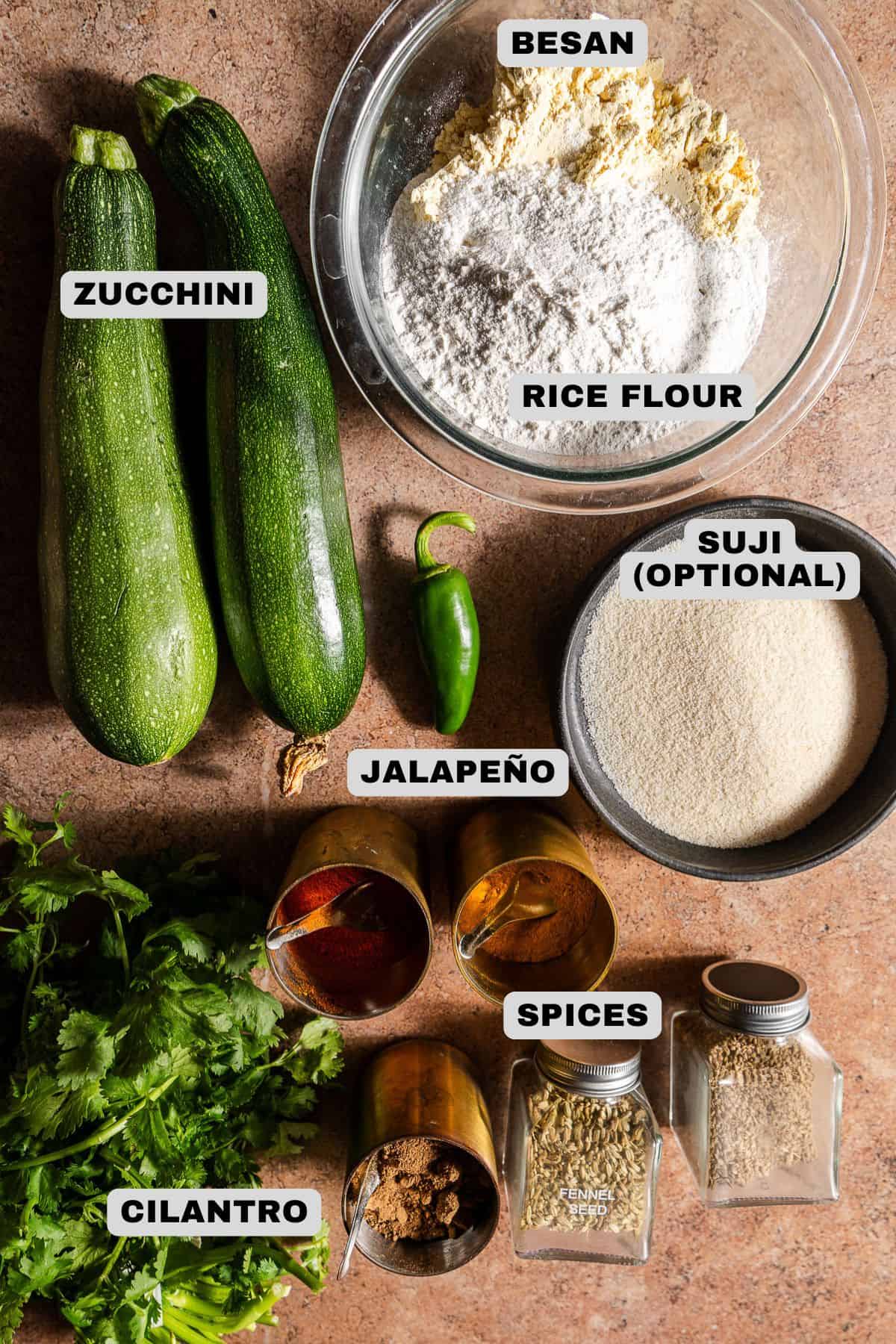
- Vegetable - During the summer, I have an insane amount of zucchini that I also think it tastes best with the kadhi. Yellow squash or bottle gourd (lauki) also work. You can also use finely sliced onion, thinly quartered potatoes, or shredded carrots instead.
- Besan - Also known as gram or chickpea flour. Typically pakoras use a 2:1 of besan to rice flour.
- Rice Flour - Aids with the crispiness and cuts down the nutty flavor from the besan. This was my biggest complaint growing up eating pakoras - I never liked the flavor of full besan pakoras so my mom substituted rice flour.
- Suji - Also known as semolina flour. This is optional, and only needed if the batter is too watery. If the batter doesn't stick together in clumps and is very liquidy, then and only then add the suji.
- Jalapeño - Can be deseeded to reduce spice. Substitute with Indian green chilis or serranos.
- Spices - Ajwain aids digestion and flavor. Substitute with cumin seeds. Additionally, we're using a mild Kashmiri chili powder, turmeric, aamchur, and ground fennel in the batter.
Now that we have the pakoras sorted, the curry itself doesn't require too many ingredients!

- Yogurt - Ideally, use dahi or plain whole milk yogurt. This is a great way to use up yogurt that's on the brink of expiration because it's tangy and has the best flavor. We've also tested this using non-fat Greek yogurt which we kept on the counter at room temperature for 2-3 hours and had the same delicious results.
- Besan - Also known as gram or chickpea flour. It adds an earthy, nutty taste to the curry while also acting as the thickening agent.
- Spices and Herbs -
- For the curry - cumin seeds, turmeric (which gives it the signature yellow color), asafoetida, garam masala, and kasuri methi (dried fenugreek leaves)
- For the tadka - a quick tempering of mustard seeds, Kashmiri chili powder, dried red chilis, asafoetida, and curry leaves in hot ghee
How to Make Pakoras
Use this in depth post for making fresh crispy Zucchini Pakoras for more information.
Start by preparing the vegetable you're going to use for the pakoras. Shred the carrots or zucchinis, finely slice the onions, or thinly slice the potatoes into quarters. Additionally, start heating neutral oil in a kadhai to fry the fritters.

- Step 1: Mix together besan, rice flour, the preferred vegetable, green chili, spices, and salt in a mixing bowl.

- Step 2: The batter should be thick and stay clumped together. If it's too watery, add the suji. They should be fried as soon as the batter is ready.
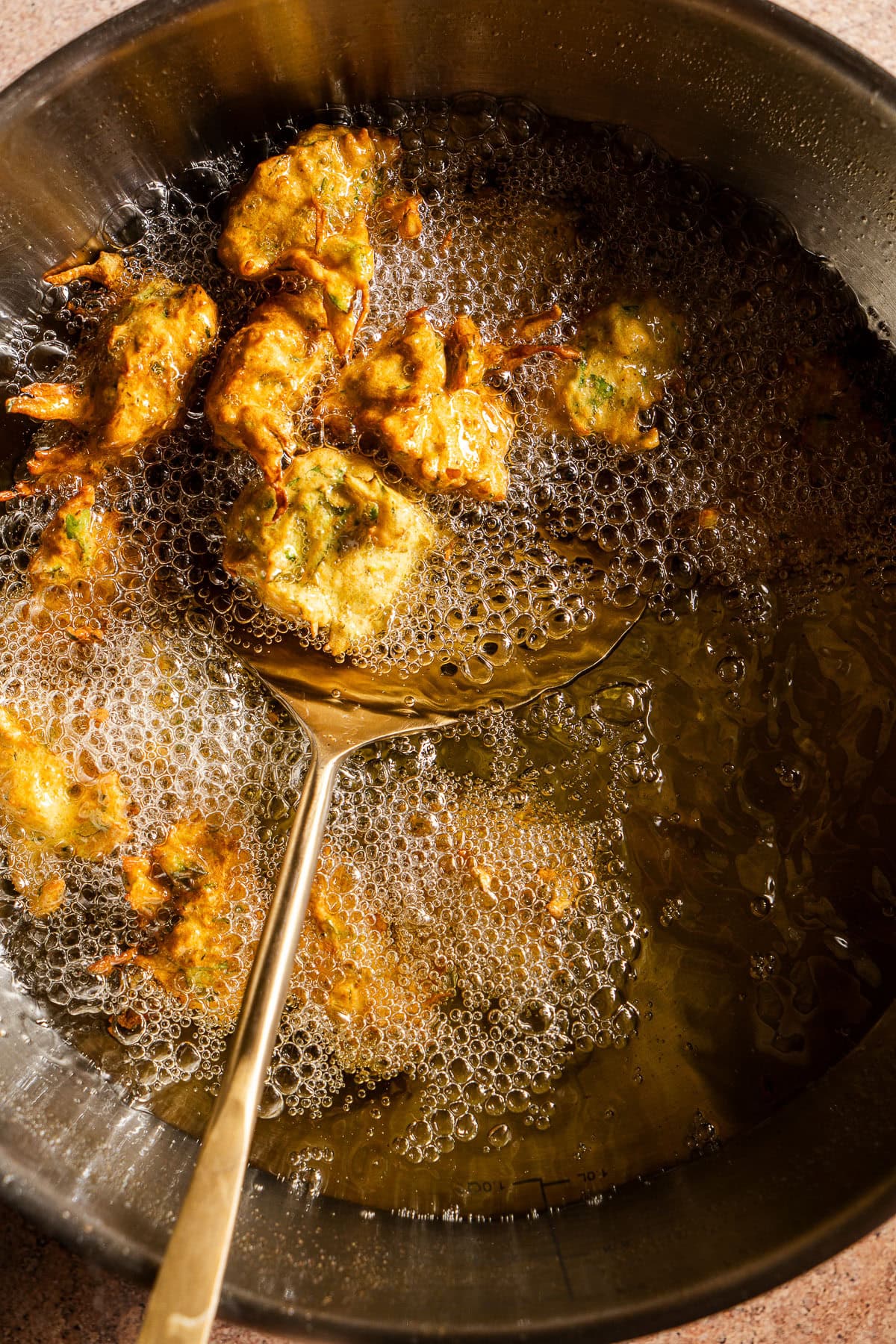
- Step 3: Use a 1 tablespoon cookie scoop to plop the batter into the hot oil, being sure not to crowd them. Keep moving them around with a slotted spoon and fry until a deep golden brown.

- Step 4: The bubbles will become smaller and smaller when done. Remove them and drain on a plate lined with a paper towel.
How to Make Kadhi Pakora

- Step 1: Start with the bowl full of yogurt. Add half the besan with a ¼ cup of water and whisk until there are no lumps. Then add another ¼ cup of water and the rest of the besan and continue to whisk until fully combined.

- Step 2: In a hot deep pot, toast the cumin seeds, turmeric, garam masala, and asafoetida for 30 seconds in a tablespoon of ghee. Pour in the besan and yogurt mixture and thin it down with 3.5 cups of water.
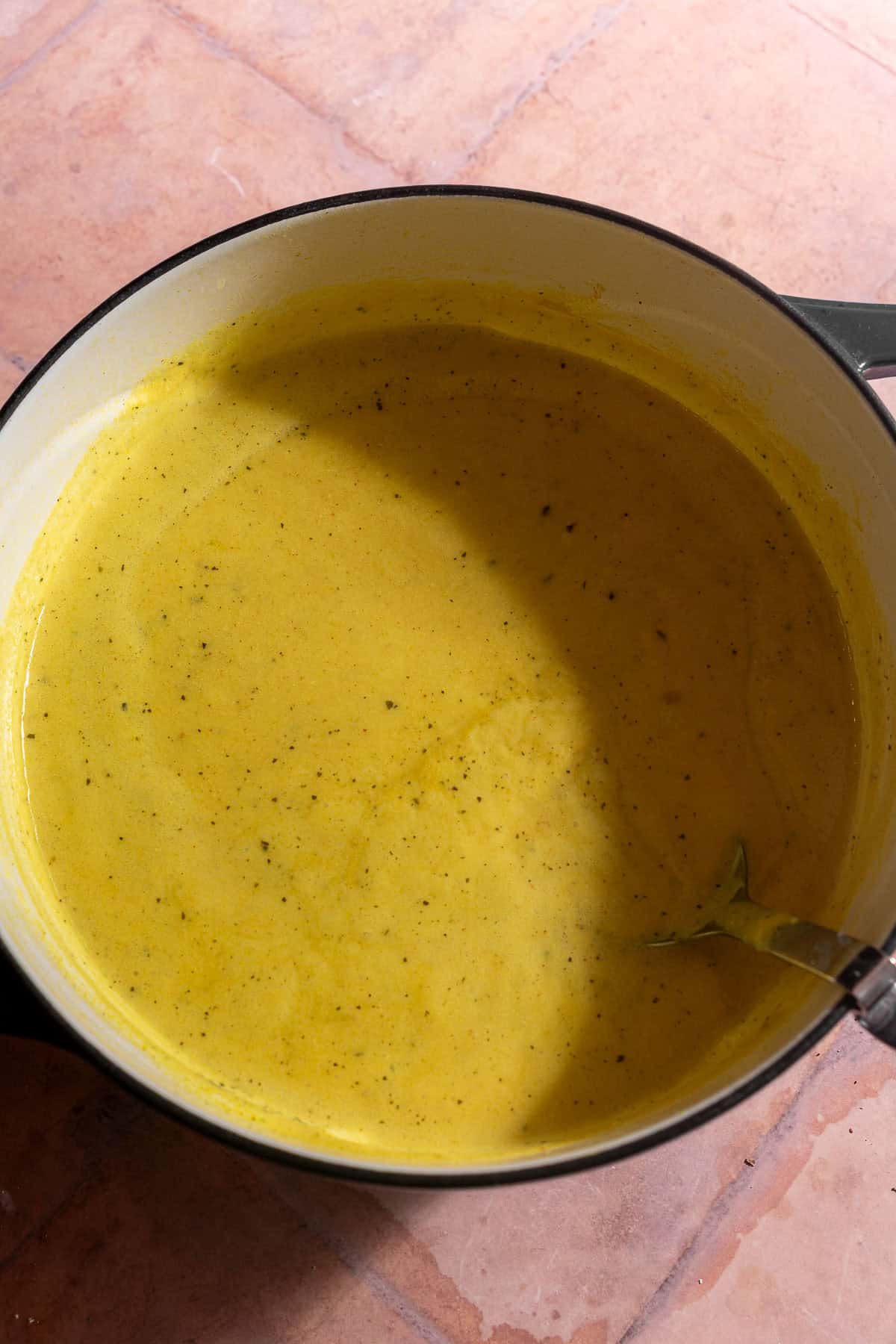
- Step 3: Keep whisking until it comes to a boil, then stir in intervals. Continue to slowly simmer on low to where it's still loose but starting to thicken, about 30 minutes, and the color is a rich golden yellow. Rub the kasuri methi between your hands and add the crushed herb to the curry.
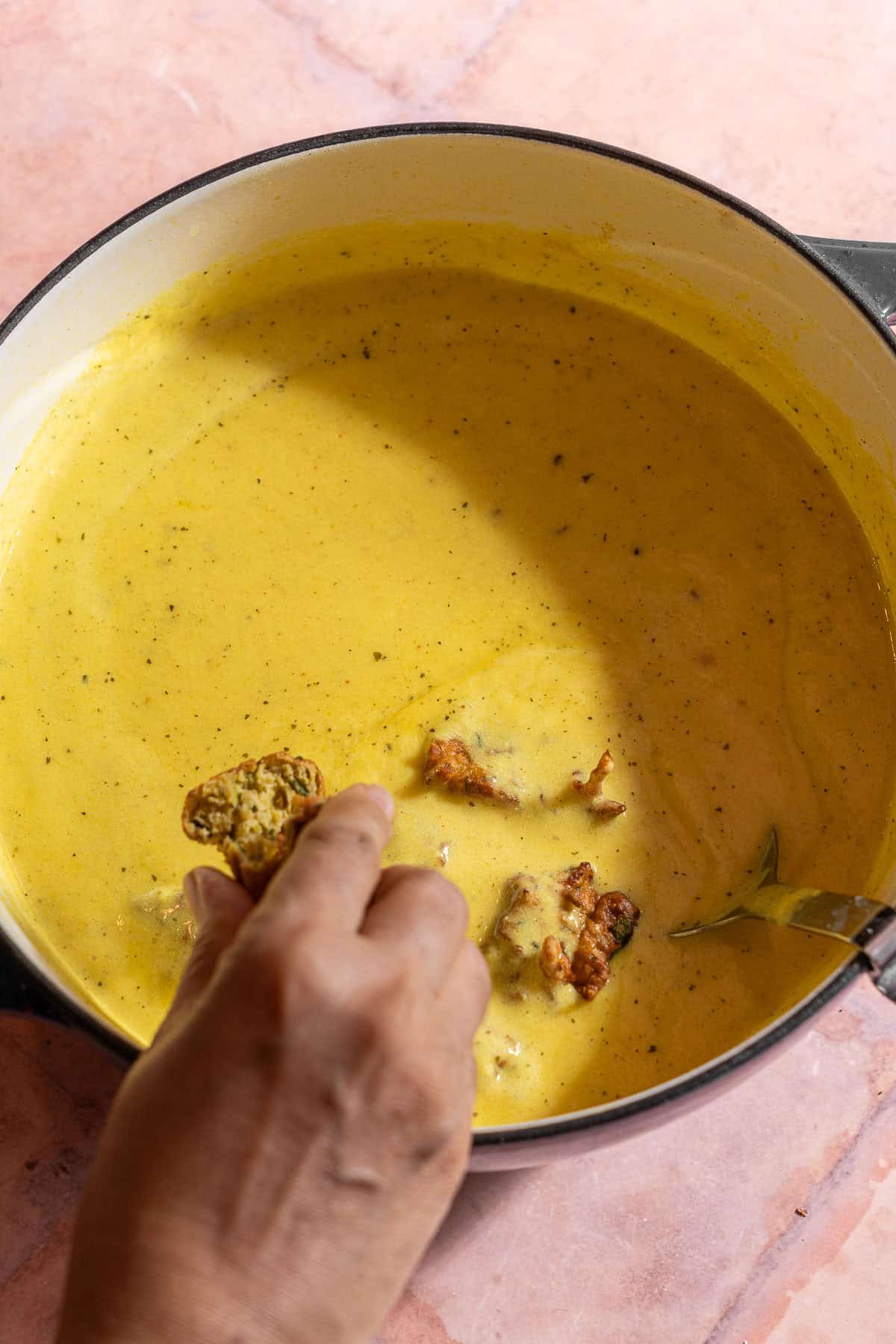
- Step 4: At this point, slightly break the pakora open and gently add it into the curry. Allow the curry to simmer for another 5-7 minutes so the pakora soaks up all the flavor. The curry should be thick at this point. Remove from heat.
Something my mom taught me to look for in terms of doneness is the bubbles. After adding the pakoras, the bubbling will be small and vigorous. Once the besan cooks off, the bubbles will be larger and slower to burst near the pakoras.
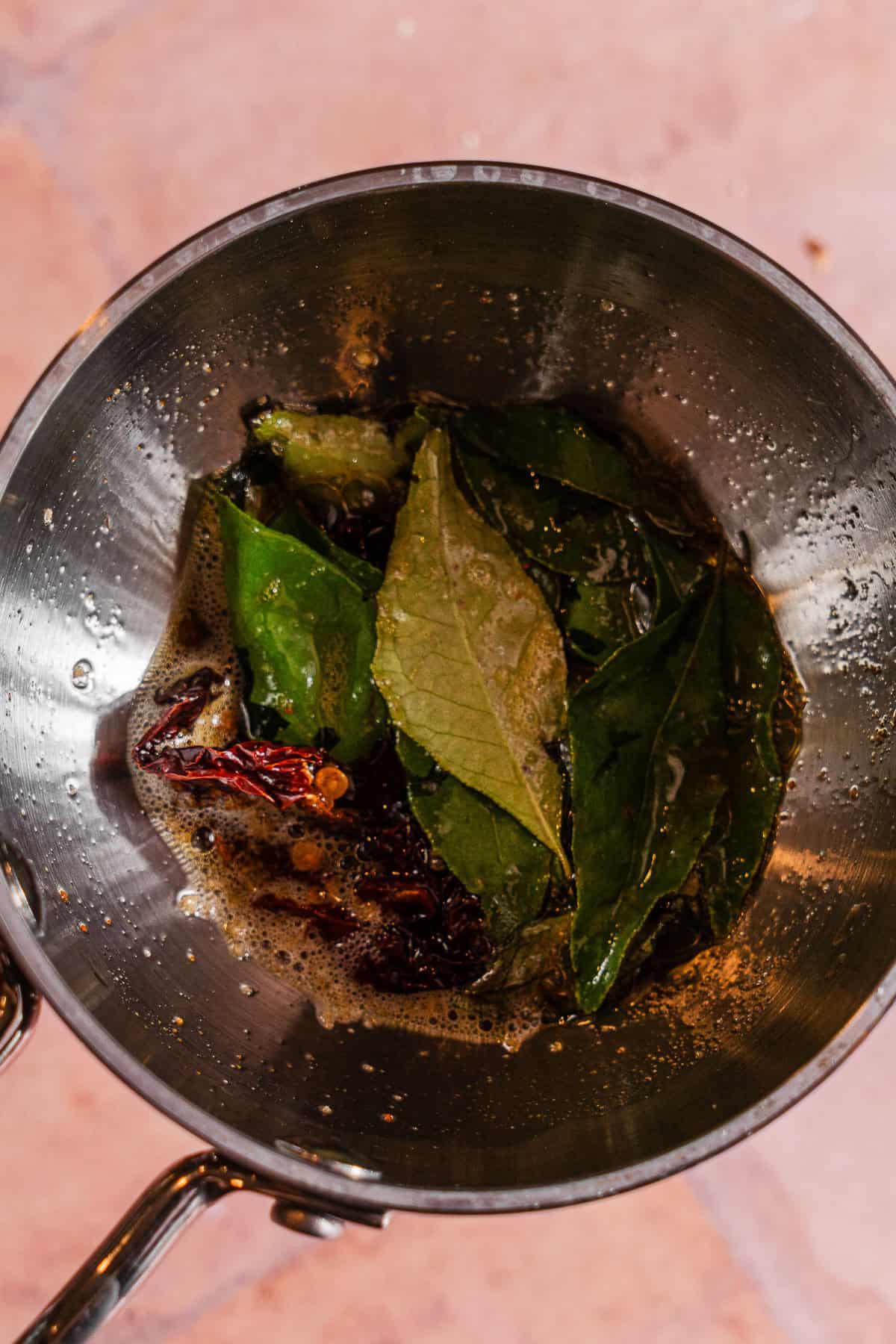
- Step 5: Heat a tablespoon of ghee in a tadka pan until it's screaming hot then remove from heat. Immediately add the mustard seeds, dried red chili, chili powder, asafoetida, and curry leaves and sizzle for a minute.

- Step 6: Pour the tadka over the kadhi and serve warm.
Serve the Kadhi with steamed basmati rice or roti with a side of achaar (pickle) or papad. Since the dish is rich and heavy, it's especially delicious with a kachumber salad or cucumber raita as a refresher.
Over time, kadhi thickens and deepens in flavor, making leftovers even better. We'd mix in leftover pieces of roti for a comforting kadhi khichdi-style dish.

Variations
- Air Fryer Pakoras: Bake or air-fry pakoras instead of deep frying for a lighter version.
- Vegetable Add-Ins: Add chopped spinach, crispy onions, or okra to the kadhi. Play around with the vegetables in the pakoras - it's delicious with potatoes, zucchini, onions, or carrots.
- Onion: Make plain pakoras or use shredded zucchini or cabbage for a sattvic version. While our curry doesn't use onions, Punjabi kadhi should start with sauteed onions until golden brown.
- Spicier Kadhi: Add crushed black pepper, red chili flakes, or more green chilies.
Expert Tips and Tricks
- Whisk well: Prevent lumps in your kadhi by whisking besan and yogurt thoroughly before heating.
- Prevent curdling: This shouldn't happen but if it does, it is due to the proteins in the yogurt. Be sure to whisk out all the lumps from the besan and yogurt, and continue to mix until it comes to a boil. It'll eventually come back together.
- Low and slow: Kadhi tastes best when simmered gently - rushing it can cause it to curdle.
- Fry pakoras fresh: For the best texture, fry pakoras just before adding to the kadhi. However, you can absolutely use pakoras that are a few days old.
- Use sour yogurt: Slightly tangy yogurt gives the most authentic flavor. If your yogurt is sweet, add a teaspoon of lemon juice.
- Tadka last: Always add the tadka at the end for the boldest flavor and aroma.
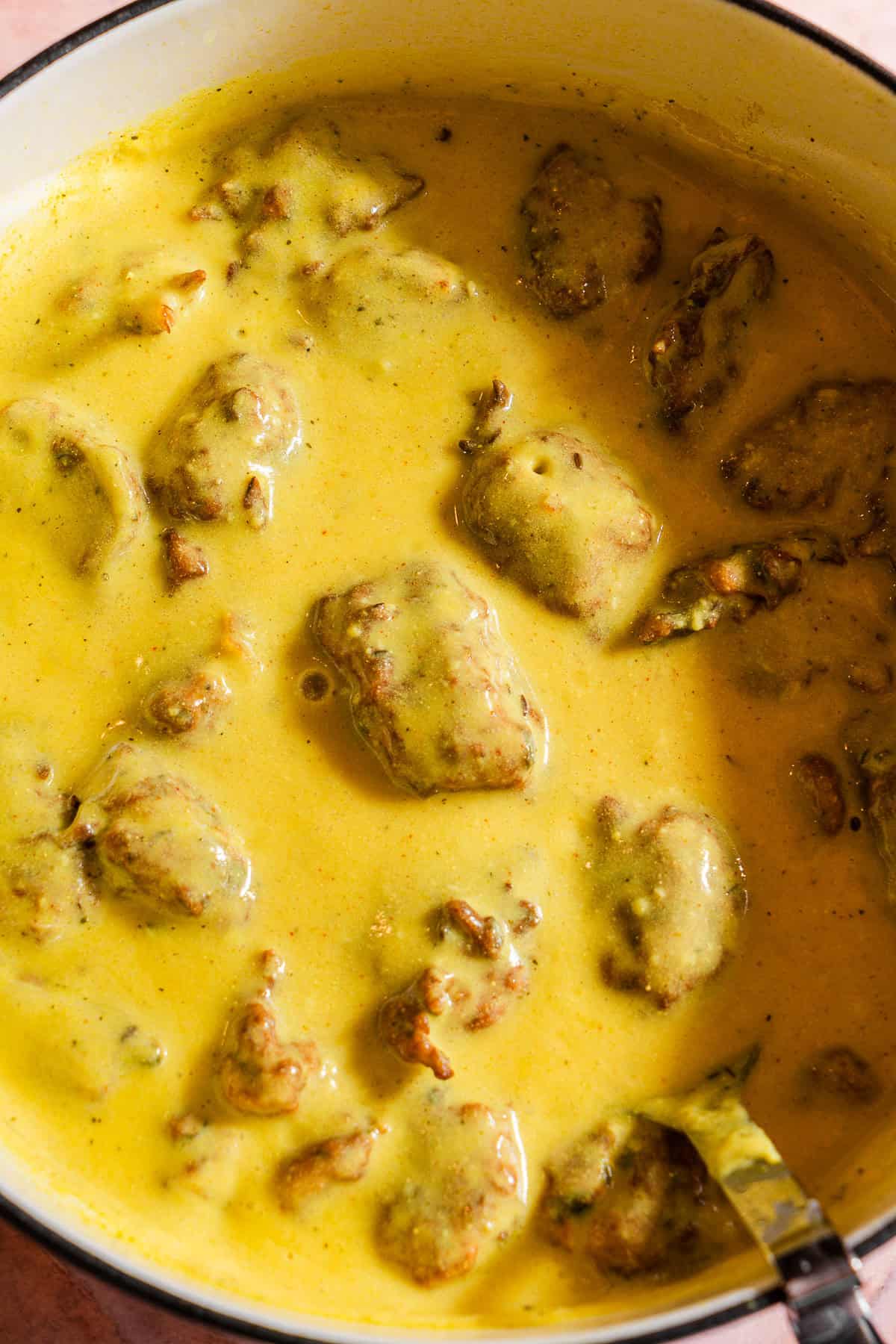
Storage Instructions
Fridge: Store kadhi in an airtight container for up to 3 days. Reheat gently on the stove - it thickens over time, so you may need to add water.
Freezing: Not recommended with pakoras inside. You can freeze just the kadhi base, then make fresh pakoras or use separately stored frozen pakoras that are thawed in the refrigerator when ready to eat.
FAQ
Kadhi can curdle if the yogurt mixture is heated too quickly or not stirred continuously. To prevent this, always cook it on low to medium heat, and stir constantly until it starts to simmer gently. Using room temperature yogurt also helps.
Yes! While pakoras add flavor and texture, you can make plain kadhi for a lighter dish. It's still delicious with rice or roti, especially when topped with a flavorful tadka.
Plant-based yogurt like unsweetened almond or coconut yogurt works well.
Use oil instead of ghee in the tadka and frying.
Yes - this recipe is naturally gluten-free as it uses besan (chickpea flour) instead of wheat flour. Just make sure your hing (asafoetida) is labeled gluten-free, as some versions are mixed with wheat flour.
This usually means the besan wasn't cooked enough. Be sure to simmer the kadhi for at least 30-40 minutes, stirring occasionally to ensure it fully cooks and develops flavor.

More Indian Curry Dishes to try
Recipe
Want to Save This Recipe?
Thinking about making this recipe? Enter your email and I'll send it straight to your inbox to save for later. Plus, get new recipe inspiration from me every week!
By submitting this form, you consent to receive emails from Masala and Chai.

Kadhi Pakora
Equipment
Ingredients
- 500 grams zucchini, shredded (or thinly sliced onions, carrots, potatoes)
- ½ cup besan (gram flour)
- ¼ cup rice flour
- ½ jalapeño, finely diced
- 2 tablespoons cilantro, chopped
- ¼ teaspoon ground turmeric
- ½ teaspoon Kashmiri chili powder
- ½ teaspoons fennel seeds, grounded
- ¼ teaspoon ajwain, crushed in hands
- ½ teaspoon aamchur
- 1 teaspoons salt
- neutral oil, for frying
Kadhi
- 400 grams whole milk plain yogurt, room temperature
- 70 grams besan (gram flour)
- 4 cups water, divided
- 1 tablespoon ghee
- ¼ teaspoon asafoetida
- 1 teaspoon cumin seeds
- 1 teaspoon ground turmeric
- ½ teaspoon garam masala
- 1 ½ teaspoons salt
- ½ tablespoon kasuri methi, crushed in hands
Tadka
- 1 tablespoon ghee
- ⅛ teaspoon asafoetida
- 1 teaspoon Kashmiri chili powder
- ½ teaspoon mustard seeds
- 1 dried red chili, broken in half
- 10 curry leaves
Instructions
Pakoras
- Heat 2-3 inches of oil in a deep pan or kadhai over medium heat.
- In a bowl, mix together the grated zucchini (or other vegetables), besan, and rice flour immediately to prevent the flour from clumping. Let it sit for 5 minutes. Then, mix in the jalapeño, cilantro, turmeric, Kashmiri chili powder, ground fennel, ajwain, aamchur, and salt to form a thick batter.
- Test the hot oil by dropping a small bit of batter - it should sizzle and rise. Drop about a tablespoon of batter into the oil and fry until a deep golden brown, turning occasionally. Remove and drain on a paper towel.
Kadhi
- In a mixing bowl, whisk together the yogurt, besan, and ½ cup of water until completely smooth.
- Heat a deep pot or dutch oven on medium heat and melt a tablespoon of ghee. Temper the asafoetida, cumin seeds, turmeric, and garam masala in the ghee for 30 seconds. Then, pour the yogurt besan mixture with the other 3 ½ cups of water and bring to a gentle boil on low to medium heat, stirring constantly to prevent curdling.
- Simmer on low for 30-40 minutes, stirring often to avoid sticking or splitting. Add 1 ½ teaspoons of salt, or to taste. Rub the kasuri methi between your hands and dump it into the pot. Stir together.
- Once the kadhi has thickened slightly and is cooked through, slightly break apart the fried pakoras and drop them in. Simmer for 5-10 minutes to let the pakoras soak and soften slightly.
Finish with Tadka
- In a small tadka pan, heat ghee or oil until screaming hot. Remove the pan from heat.
- Add Kashmiri chili powder, mustard seeds, dried red chilies, curry leaves, and a pinch of hing. Once sizzling and aromatic, about a minute, pour the tempering over the kadhi.
- Serve the Kadhi hot with roti, naan, or basmati rice.


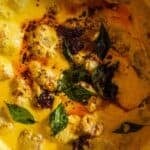

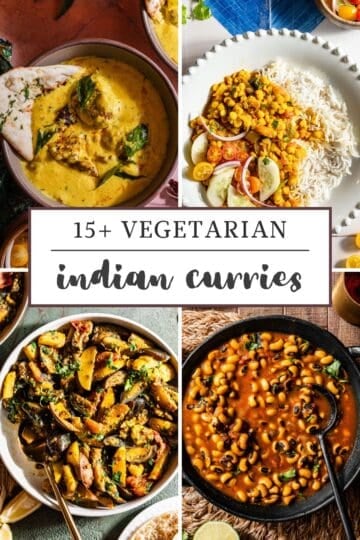


Anonymous says